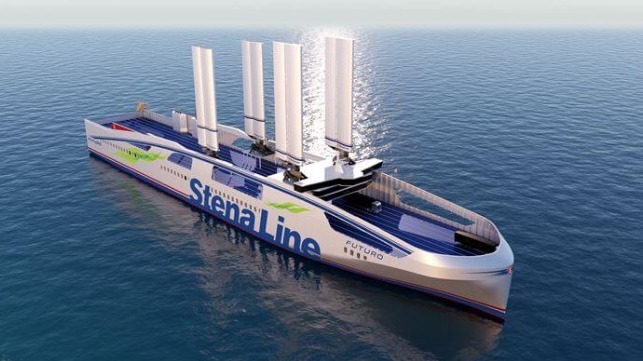Stena Presents Futuro Concept RoRo that Would Reduce Energy Usage 20%

Stena Line, one of Europe's leading ferry companies and a pioneer with advanced designs, presented its latest thinking for Stena Futuro, a RoRo that would reduce energy usage by 20 percent or more. The company’s goal is an overall 30 percent reduction in its CO2 emissions by 2030.
“The mission is to develop the most efficient and competitive vessel possible for a specific cargo capacity, using today’s available technology. The goal is for the vessel to have the lowest fuel consumption on the market,” says Nicolas Bathfield, Project Manager at Stena Teknik, who has been involved in developing the concept.
Stena Futuro would be a 240-meter (787-foot) long RoRo vessel intended for transporting semi-trailers and cars. Stena Teknik, a resource within the group for all its business units, is exploring the full range of technologies to advance the efficiency of this next-generation vessel. The group is focused on newbuilds as well as the energy and digital transformation mostly in the maritime sectors.

Stena Line's latest concept for the new generation of vessels uses a low and streamlined design to reach its ambitions. The hull and superstructure have been optimized to achieve the most efficient use of cargo space possible. At the same time, low weight and optimized hydro- and aerodynamics are central to achieving low fuel consumption. The hull of Stena Futuro would also be equipped with an air lubrication system.
The concept for Stena Futuro also includes four 40-meter (131-foot) tall wing sails, which can be retracted when needed — for example, when passing under a bridge. Recently, Stena’s developers, together with the Swedish research institute RISE, have conducted tests and simulations of the sails’ usage to document both energy savings and how the sails affect the ship’s maneuverability and safety.

“The tests showed that Stena Futuro’s sails could potentially result in as much as 15 percent fuel savings. We also confirmed that the vessel meets all requirements for stability and maneuverability in scenarios such as sudden wind shifts or quick course changes,” says Bathfield.
The vessel would also have hybrid propulsion, batteries, and engines with low fuel consumption that can run on several different fuels. The battery system makes it ready to partly operate the vessel on electricity alone, for example, when entering and leaving ports. Solar panels will also contribute to the ship’s electricity needs. A waste heat recovery system will make it possible to reuse the hot exhaust gases from the ship’s engines to meet other onboard heating needs as well as supporting electric power generation.
Stena says the ship design will play a vital part in its future tonnage planning in the coming years. Currently, however, there is no finalized plan for the production of Stena Futuro.
